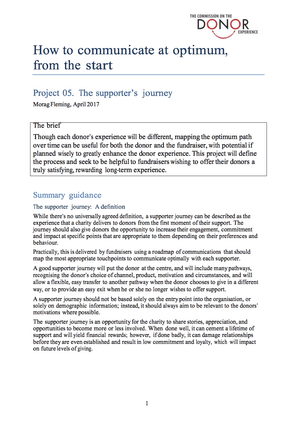CDE project 5 section 5: from donor journeys to supporter journeys
- Written by
- The Commission on the Donor Experience
- Added
- April 23, 2017
Ellen Janssens - Dutch Heart Foundation
In ‘The Big Five Trends in Fundraising – Are you prepared?’ a number of questions were raised on the future of the donor journey. On the future of fundraising. For example:
• How will we fundraise in two to five years?
• How will we cooperate, within and outside of our organisation?
• What will be the non-fundraising engagement stages that we can offer to donors, to enhance their journey with us?
In my personal opinion, separate fundraising departments will no longer exist in five years. More and more, donors want to feel part of the mission they support. They want to be able to contribute on their own terms, be part of the solution. Non-profits need to make the transition of thinking in transactions to thinking in relations. However, to be able to facilitate supporters in contributing to our mission with their time, knowledge or network, we need a close cooperation with all departments within our non-profit. Other technological opportunities, like Experience marketing (Virtual Reality and Augmented Reality, facilitating ways to experience both the need for, as well as the impact of their contribution), Digital transformation (blogs, chats, videos) and the customer needs behind the Block chain technology (enforcing transparent and earmarked donations) also require an extremely close cooperation between the departments. Between the fundraisers and (the activities for) the beneficiaries.
I strongly believe in 5 years we will have integrated teams, responsible for specific combinations of non-profit activities and donor segments, instead of separate departments separated by their specific tasks.
Donors will become supporters. New supporters will want to be able to share their time, data, knowledge, experience, network and/or opinion and take more ownership of their contribution to charity’s mission. The Children’s Society posted an excellent presentation on this subject: From Fundraising to Engagement Building.
We could see this as a threat, but I’m personally convinced this is nothing more than a huge opportunity for non-profits. It provides us with an excellent (and necessary) way to engage with our supporters before asking for their money. The first point of entry in Donor Journeys will be different ways to engage with the organisation, based on the needs of the supporter, not on our needs. e.g. for us as a health organisation, this might be a contribution in time (volunteering). Or in data (providing us with health measurements to accelerate research). Or expertise/vote in deciding which research we should focus on.
This will also have a huge impact on their loyalty, but even better: it will facilitate non-profits in fulfilling their mission in the most optimal way. The networks of engaged supporters, their (collective) knowledge and experiences can be extremely valuable assets, probably even more valuable than their financial donations.
For example, the infinite value for innovation. New technological opportunities arrive at an ever growing pace. New entrants in the charity arena are introducing new business models and new ways to ‘do good’. Value chains are changing, roles are disappearing; every organisation has to reconsider and prove its added value. Innovation, creating new business models and marketing propositions can only be successful if its customer driven. Or even better, based on co-creation. For that, we need the cooperation and knowledge of our supporters, individuals as well as corporates.
So, the real question should be if the ultimate goal of a customer journey should always be to ask for money. Or: how can we measure a supporter’s Life Time Value when it comes to his or her contribution in time, network, etc.
Another important part of the supporter journey will be the interaction. The part where we get to know our supporter. Find out their needs, their motivation to contribute, and the ways they can and want to contribute to our cause. We have to find ways to make it interesting for our supporters to share this information with us, to convince them that we want to provide us much value to them as possible.
With every interaction with our supporter, the ‘what’s in it for them’ should be clear.
As a health organisation, we could for example provide health advice, recipes or training schedules. Or feedback on what we were able to accomplish with the time, data or money they provided to us.


















